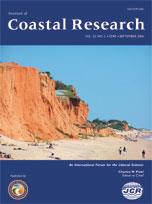Previous research has demonstrated that reconnection of impounded wetlands to the Indian River Lagoon benefits estuarine fisheries and emergent ecosystems. However, no effort has yet been made to quantify the effects of managed surface water flow on patterns of sedimentation. Sedimentation patterns strongly influence wetland evolution, including the distribution of open water and emergent landscapes. Thus, the enumeration of sedimentation rates provides a basis for reconstructing the processes responsible for historic landscape change. These data also provide a basis for predicting landscape change that can accompany hydrologic reconnection of impounded wetlands to the Indian River Lagoon.
In this investigation, conducted in the Merritt Island National Wildlife Refuge, Florida, we used cesium activity profiles to quantify rates of historic sediment accumulation at locations subject to managed (impounded) and unmanaged (natural) surface water hydrology. The data suggest impounded wetlands subject to historic submergence are now devoid of vegetation and experiencing substrate erosion in areas in which fetch is sufficient to induce wind-driven circulation. In unmanaged wetlands, surface elevations have kept pace with historic sea level rise solely through the in situ accumulation of organic matter.
These observations suggest that hydrologic reconnection of impounded wetlands subject to persistent flooding throughout historic time will result in rapid and widespread submergence to water depths in excess of 10 to 20 cm. At these depths, most wetland plant taxa will not successfully recruit via seedling exchange. Hence, attempts to restore wetland areas analogous to those investigated during this study (i.e., Impoundment D) cannot be achieved simply by removing management structures that obstruct natural surface water flow. The wetland surface must either be (1) incrementally flooded to estuarine water level elevations slowly over time or (2) raised to the appropriate hydroperiod elevation before reconnection with suitable fill material. One possible source of fill is the Intracoastal Waterway, located within 2 km of the Merritt Island National Wildlife Refuge and intermittently dredged to maintain safe navigation.





